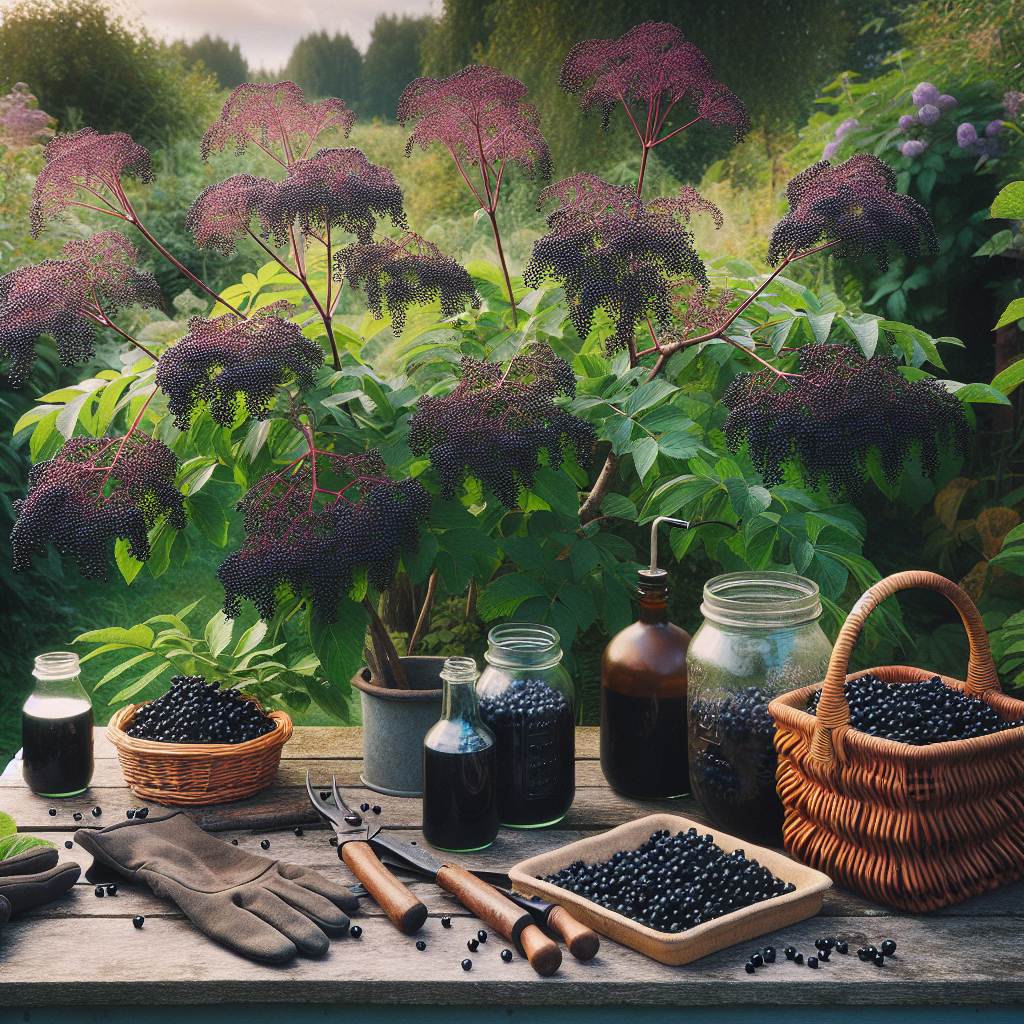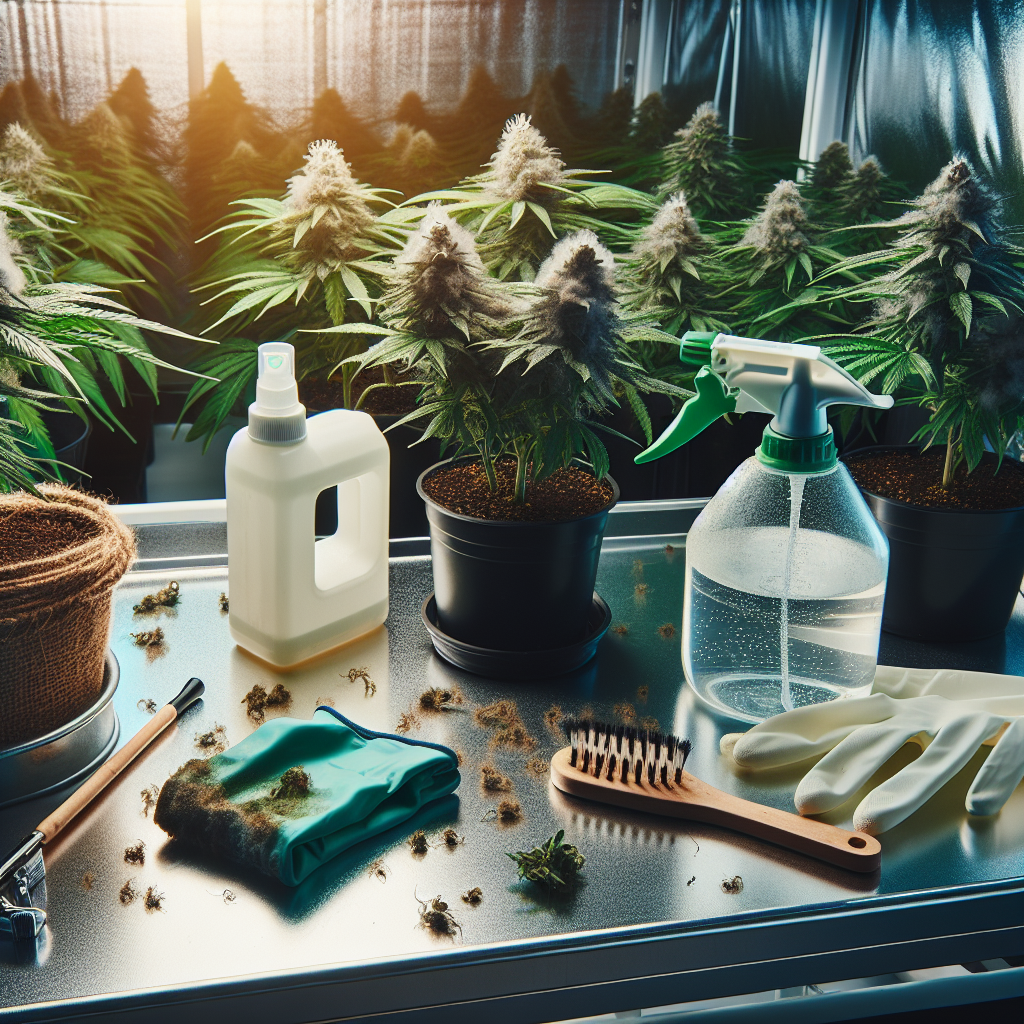A Gardener’s Guide to Growing Elderberries for Homemade Preserves
Updated July 24, 2024 at 3:18 am

Understanding the Basics of Elderberry Cultivation
-
Pet Friendly
Elderberries are not particularly toxic to pets, but their stems, leaves and unripe berries contain cyanogenic glycosides, which can cause upset stomachs. It’s always best to err on the side of caution and keep these plants out of reach.
Light Requirements
These fruiting shrubs thrive in full sun to partial shade. Ensure they get at least 6-8 hours of direct sunlight daily for optimal berry production.
Watering
Elderberries like consistently moist soil. They require regular watering, especially during dry spells to support their growth and fruiting capacity.
Humidity
As plants native to a variety of environments, elderberries adapt well to different humidity levels, though they do best in moderately humid conditions.
Temperature
Elderberries are hardy in USDA zones 3-9, making them adaptable to a wide range of temperatures, and they can survive harsh winters.
Difficulty
They are considered moderately easy to grow, making them suitable for both novice and experienced gardeners.
Selecting the Right Variety of Elderberry
There are several varieties of elderberries to choose from, each with its own unique flavor and growing characteristics. The popular ‘York’ and ‘Nova’ varieties are known for their large clusters of berries and high yields. If you’re looking for disease resistance, ‘Johns’ might be the variety you need.
Preparing Your Garden for Elderberry Planting
Preparation is key for a bountiful elderberry harvest. Choose a location with good drainage to prevent root rot. Consider adding organic matter to enrich the soil. Perform a soil test to determine any specific nutrient needs, so you can amend the soil accordingly.
Planting and Caring for Your Elderberry Bushes
Plant elderberry bushes in early spring, spacing them 6-10 feet apart to allow for growth. After planting, mulch around the base to retain moisture and suppress weeds. Fertilize annually with a balanced fertilizer to ensure healthy growth.
Pruning and Maintaining Elderberry Plants
Proper pruning enhances the health and productivity of your elderberries. Prune out dead or diseased branches in early spring, and after a few years, start to remove older canes to encourage new growth. Pruning also keeps the plants to a manageable size for easier harvesting.
Harvesting Elderberries at the Right Time
Timing is everything when it comes to harvesting elderberries. Wait until the berries are fully ripe—usually around late summer to early fall—when they turn a deep purple-black. Remember to harvest early in the day for the best flavor and to handle the berries gently.
Pest and Disease Management for Healthy Elderberries
Elderberry plants are generally quite hardy, but they can fall prey to certain pests and diseases. Aphids and birds are common nuisances. Netting is an effective bird deterrent, while a strong spray of water can dislodge aphids. Watching for signs of rust or powdery mildew and addressing issues promptly will keep your plants strong.
Processing Elderberries for Preserves
Once harvested, you must process elderberries quickly to maintain their quality. Remove the berries from their stems, wash them thoroughly, and then cook them down to make your own jams, jellies, or syrups. Don’t forget to add pectin to aid in the setting process if you’re making jams or jellies.
Creating Delicious Homemade Elderberry Preserves
Making your own preserves is a rewarding process. Start with a basic recipe and adjust the sugar and pectin to suit your taste. Store your finished product in sterilized jars and enjoy the fruits of your labor all year long.
Understanding the Health Benefits of Elderberries
Elderberries aren’t just tasty—they are packed with vitamins, antioxidants, and immune-boosting properties. Integrating elderberry preserves into your diet can be a delicious way to promote overall health.
Incorporating Elderberry Plants into Your Garden Landscape
Apart from yielding delicious fruit, elderberry plants also enhance the aesthetic appeal of your garden with their lovely flowers and lush foliage. They can serve as a natural privacy screen or as part of a mixed border with other perennials.
Maximizing Yield and Ensuring Quality Berries
To achieve the highest quality and quantity of berries, consider companion planting with another variety for cross-pollination. Regular watering, mulching, and fertilizing will also contribute significantly to a bountiful harvest.
Storing and Preserving Your Elderberry Harvest
If you have a larger harvest than you can process immediately, you can freeze elderberries for later use. Spread them out in a single layer on a baking sheet to freeze, then transfer them to airtight containers or freezer bags.
Engaging in Community and Sharing the Harvest
Gardening is not just about the harvest; it’s also about community. Sharing your surplus elderberries or preserves with neighbors or at local food swaps can build relationships and create a sense of togetherness.
Exploring the Versatility of Elderberries in Recipes
Elderberries don’t just make great preserves; they’re incredibly versatile in cooking and baking. Beyond jams and jellies, try using them in sauces, pies, or even elderberry wine. Their unique flavor can add depth to a variety of dishes.
Tools and Supplies to Help Your Elderberry Garden Grow
As with any gardening endeavor, having the right tools can make all the difference. For elderberries, a good pair of pruning shears, bird netting, and a durable harvesting basket are essentials.
Find This and More on Amazon
Reflecting on the Rewards of Growing Your Own Elderberries
When all is said and done, the effort of growing, nurturing, and harvesting your own elderberries for preserves is a genuinely fulfilling endeavor. Connecting to the land and contributing to your self-sustainability are just a few of the rewards that come with the gardening territory.
Choosing the Ideal Elderberry Location in Your Garden
Locating the perfect spot for your elderberry plants is crucial. Elderberries need to be placed where they will receive adequate sunlight and have good air circulation to reduce the risk of diseases. Avoid low-lying areas that could become waterlogged.
Improving Soil Quality for Elderberry Plant Success
To provide the best foundation for your elderberries, it’s beneficial to work with the soil. Incorporating compost or well-rotted manure can improve soil structure and fertility. This organic matter not only feeds your plants but also improves drainage.
Mulching to Protect and Nourish Elderberry Plants
Mulch is your ally in the elderberry garden. It conserves moisture, keeps roots cool, and helps with weed suppression. Organic mulches like straw or wood chips are recommended as they break down over time, enriching the soil.
Watering Techniques for Thriving Elderberry Bushes
Adequate watering is key, but overwatering can be detrimental. Drip irrigation or soaker hoses are ideal for elderberries, providing a steady supply of moisture directly to the roots and avoiding wetting the foliage which can invite disease.
Understanding Fertilization Requirements for Elderberry Growth
When it comes to fertilizing, elderberries are not particularly demanding. A top dressing of compost in the spring can be sufficient. However, if your soil test indicates a deficiency, a balanced slow-release fertilizer can provide necessary nutrients.
Recognizing Signs of Elderberry Stress and Solutions
If your elderberries are looking lackluster, there could be a few reasons. Yellowing leaves might indicate overwatering or poor drainage, while stunted growth could be a sign of nutrient deficiency. Adjust your care routine accordingly to address these stress signs.
Navigating the Elderberry’s Pruning Requirements
Pruning isn’t just about removing dead wood. In the case of elderberries, it’s also about shaping the plant and encouraging the development of fruitful canes. Proper pruning technique is an essential skill for yielding high-quality fruit.
Battling Against Pest Intrusions in Elderberry Bushes
While elderberries have few pests, vigilance is key. Birds love the berries just as much as we do, and they can strip a bush before you’ve had a chance to harvest. Reflective tape, scarecrows, and decoys can help protect your crop from winged thieves.
Fighting Elderberry Diseases with Organic and Chemical Controls
Preventing disease in elderberries often comes down to plant hygiene. Removing fallen leaves and pruning out any infected areas can reduce the risk of disease. If you need to resort to treatments, there are both organic and chemical options available.
Companion Planting for a Healthier Elderberry Ecosystem
Companion planting can offer numerous benefits such as improving pollination and controlling pests. Plants like yarrow, anise, and tansy can attract beneficial insects, while legumes can increase soil nitrogen, promoting healthier elderberry growth.
Timing and Technique: Efficient Elderberry Harvesting
With practice, you’ll learn to identify the perfect moment to pick elderberries. A ripe berry is soft and deeply colored. Use a gentle hand when harvesting to avoid crushing the delicate fruit. A small clipper can be helpful to remove clusters from the plant.
Utilizing Proper Storage for Your Elderberry Bounty
Once picked, elderberries are prone to spoilage, so it’s important to get them into cold storage quickly. A refrigerator or cool, dark place can help preserve them until you’re ready to process them. Remember, your hard work deserves to last!
Ensuring Safe Consumption of Elderberries
While ripe elderberries are a culinary delight, all parts of the plant, especially the seeds, contain compounds that can be toxic if consumed in large amounts. Cooking or properly processing the berries destroys these compounds, making them safe to eat.
Mastering the Art of Making Elderberry Preserves
Making elderberry preserves is both a science and an art. Exact measurements, timing, and handling are crucial for a good set. But don’t be afraid to express creativity with flavor additions. A hint of lemon zest or a splash of vanilla can transform your preserves.
Creative Culinary Uses for Your Homegrown Elderberries
Apart from preserves, your homegrown elderberries can be transformed into all sorts of delicious creations. Whether it’s elderberry pie, infusion in beverages, or a drizzle on desserts, these versatile berries will delight your palate in multiple forms.
Integrating Elderberries into a Sustainable Lifestyle
Growing elderberries supports a sustainable approach to living. By raising your own fruit, you’re reducing dependency on store-bought goods, minimizing food miles, and ensuring you have access to organic, pesticide-free preserves.
Becoming an Elderberry Expert Through Community Collaboration
Don’t shy away from engaging with other elderberry enthusiasts. Local gardening clubs, online forums, and agricultural extension offices can offer invaluable advice and support. Collaborating can enhance your knowledge and success with elderberry cultivation.
Resources for Continued Learning on Elderberry Cultivation
The journey to becoming a proficient elderberry gardener doesn’t stop with the harvest. There are plenty of resources such as books, gardening courses, and workshops that can deepen your understanding and appreciation of these versatile plants.
Reflecting on the Role of Elderberries in History and Culture
Elderberries have a rich history in folklore and traditional medicine. Reflecting on this heritage can give you a deeper connection to the plants you’re nurturing and the preserves you’re creating, rooting your gardening practice in a broader cultural narrative.
Embracing Organic Practices in Elderberry Cultivation
Adopting organic practices in growing elderberries can enhance the health benefits of your preserves. By avoiding synthetic pesticides and fertilizers, you’re ensuring the purity of your fruit and contributing to a healthier ecosystem in your own backyard.
Planning for Long-Term Maintenance and Expansion
As you gain experience with elderberries, you might consider expanding your patch or diversifying your varieties. Planning for the long term means considering space, variety adaptation, and your own capacity for maintenance and harvest.
Discovering the Joy of Elderberry Cultivation and Preservation
The journey from planting to preserving elderberries is full of learning, challenges, and ultimately, rewards. Each jar of homemade preserves encapsulates the care and dedication you’ve invested, and there’s immense satisfaction in that simple truth.
Gaining Insights from Fellow Gardener Experiences
Learning from others who have walked the path of cultivating elderberries can be invaluable. Sharing triumphs and setbacks with fellow gardeners either in person or through social platforms can offer you real-world insights and tips that can greatly aid your elderberry journey.
Finding the Perfect Elderberry Varieties for Your Climate
Different elderberry varieties react uniquely to climatic conditions. Researching and selecting varieties that can flourish in your specific climate will yield healthier plants and a more abundant harvest. Speak to local growers or look for online regional gardening guides for advice.
Adapting Elderberry Cultivation to Small Spaces
Don’t let limited space hold you back from growing elderberries. With the right approach, even those with smaller gardens or just a balcony can grow elderberry bushes in containers. Select dwarf varieties and provide ample care to enjoy a miniature elderberry orchard.
Using Elderberries as a Natural Dye
Interestingly, elderberries have been traditionally used as a natural dye for fabrics. Their deep purple hue can lend a beautiful color to textiles, offering you another creative way to use your harvest while embracing a sustainable hobby.
Participating in Elderberry Festivals and Contests
Elderberries have a growing following, and participating in festivals or contests can be a fun way to engage with the community. From showcasing your homemade preserves to learning new recipes, these events are a celebration of all things elderberry.
Future Trends in Elderberry Cultivation
As interest in health and homegrown foods continues to rise, elderberry cultivation is poised for growth. Keeping abreast of future trends in agriculture and horticulture can provide you with the latest methods for growing and processing elderberries more efficiently.
Summing Up: Growing Elderberries for Homemade Preserves
Embarking on the adventure of growing elderberries for homemade preserves is both a delightful and pragmatic endeavor. It blends the joys of gardening with the pleasure of creating delicious, health-promoting treats in your kitchen. With the right knowledge and a dash of patience, you can turn your elderberry patch into a bountiful source of joy and wellness for years to come.
Shop more on Amazon


